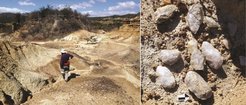Fourteen Years of Archaeological and Heritage Research in the Iringa Region, Tanzania
A new study details 67 sites spanning from the Early Stone Age to the recent past


The Iringa region of Tanzania is famous among archaeologists for the Acheulean site Isimila, and among historians as the stronghold where Chief Mkwawa led the Hehe resistance against German colonial forces in the 1890s. However, research over the past 14 years reveals that Iringa’s rich archaeological record is not limited to these two distant points in time, but spans the period from the Stone Age into the recent past. A new article published in African Archaeological Review summarizes the results of research by the Iringa Region Archaeological Project (IRAP). IRAP is based at the University of Alberta, Canada, under the direction of Dr. Pamela Willoughby. Dr. Jennifer Midori Miller of the Department of Archaeology, Max Planck Institute for the Science of Human History, is the lead author of the study.

Since 2006, the IRAP team has recorded 67 sites, which only scratches the surface of the archaeological potential in the area. These sites, some of which were recorded in conjunction with local participants, have archaeological components characteristic of the Early, Middle, and Later Stone Age, the Iron Age, and the recent past. The scientists hope that this work inspires future research, tourism, and conservation efforts in the area.


